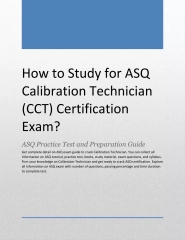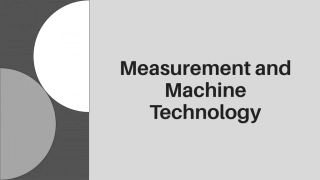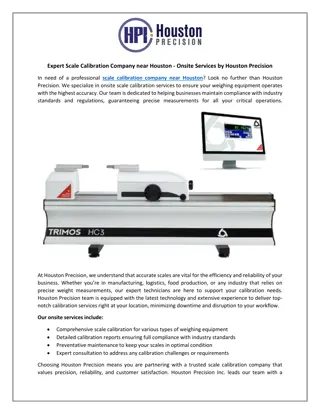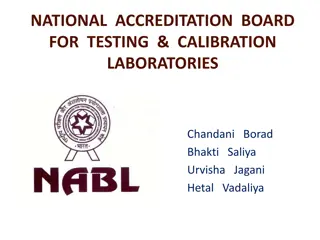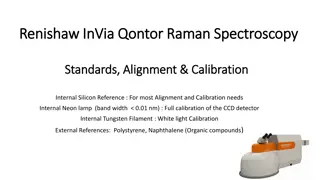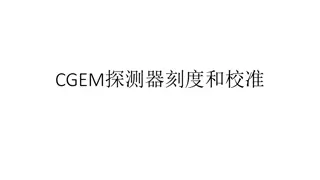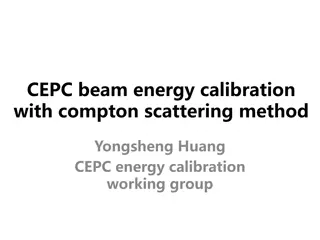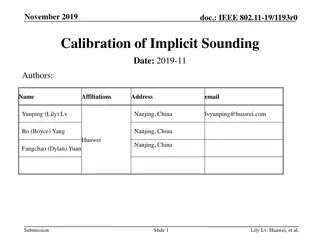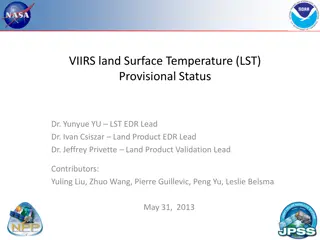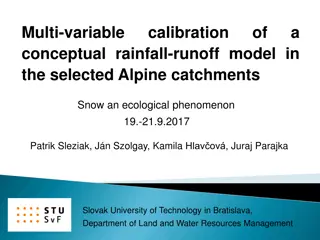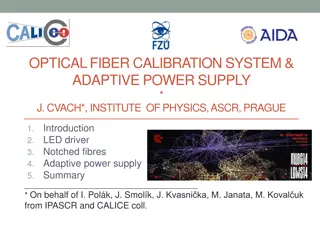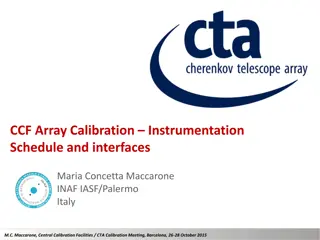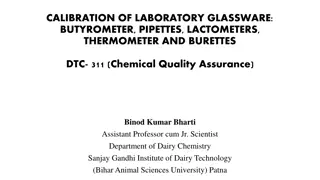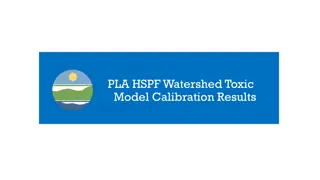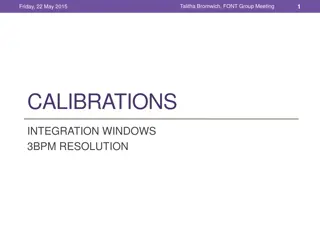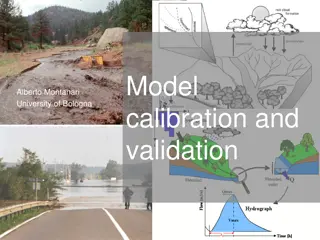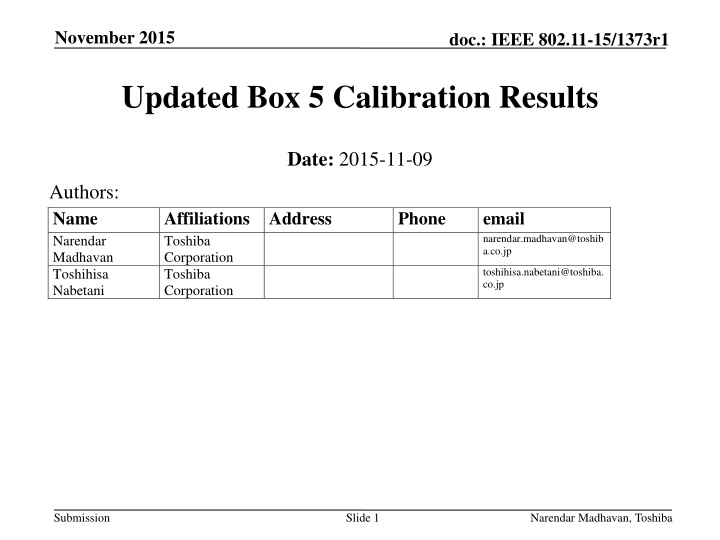
Calibration Results for IEEE 802.11-15/1373r1 - November 2015 Update
Discover the updated calibration results for IEEE 802.11-15/1373r1 in November 2015, including simulation conditions, BSS results, and PHY/MAC parameters discussed by authors from Toshiba Corporation. Explore the detailed findings and comparisons presented in this document.
Download Presentation

Please find below an Image/Link to download the presentation.
The content on the website is provided AS IS for your information and personal use only. It may not be sold, licensed, or shared on other websites without obtaining consent from the author. If you encounter any issues during the download, it is possible that the publisher has removed the file from their server.
You are allowed to download the files provided on this website for personal or commercial use, subject to the condition that they are used lawfully. All files are the property of their respective owners.
The content on the website is provided AS IS for your information and personal use only. It may not be sold, licensed, or shared on other websites without obtaining consent from the author.
E N D
Presentation Transcript
November 2015 doc.: IEEE 802.11-15/1373r1 Updated Box 5 Calibration Results Date: 2015-11-09 Authors: Name Narendar Madhavan Toshihisa Nabetani Affiliations Address Toshiba Corporation Toshiba Corporation Phone email narendar.madhavan@toshib a.co.jp toshihisa.nabetani@toshiba. co.jp Submission Slide 1 Narendar Madhavan, Toshiba
November 2015 doc.: IEEE 802.11-15/1373r1 Abstract In July meeting, some updated simulation conditions were summarized and 1 BSS results presented in [1]. In this contribution, we present the updated results for: 2 BSS and 3 BSS results with defined traffic flow; Comparison plots with some discussion; Submission Slide 2 Narendar Madhavan, Toshiba
November 2015 doc.: IEEE 802.11-15/1373r1 PHY Parameters PHY parameters All BSSs at 5GHz [80 MHz, no dynamic bandwidth] Aligned primary 20MHz channel for each co-80MHz-channel BSS; BW Primary channel The detection of preamble and BA should only focus on primary 20MHz TGac D NLOS per link iid log-normal shadowing (5 or 0 dB standard deviation) per link Channel model Shadow fading Preamble Type Control: legacy 20us; Data: 11ac (20us+20us for 1antenna case) AP/STA TX Power Power Spectral density number of antennas at AP /STA AP /STA antenna gain Noise Figure CCA-ED threshold Rx sensitivity/CCA-SD Link Adaption Channel estimation PHY abstraction Symbol length 20/15 dBm per antenna Scaled to 80 MHz 1/1 0/-2 dBi 7dB -56 dBm (measured across the entire bandwidth after large-scale fading) -76 dBm (a packet with lower rx power is dropped) Fixed MCS =5 for 11ac SS6 and TBD for 11ax SS1-4 Ideal unless otherwise specified RBIR, BCC (see appendix 1&3 in [2]) 4us with 800ns GI per OFDM symbol Submission Slide 3 Narendar Madhavan, Toshiba
November 2015 doc.: IEEE 802.11-15/1373r1 MAC Parameters MAC parameters Access protocol Queue length [EDCA, AC_BE with default parameters] [CWmin = 15, CWmax = 1023, AIFSn=3 ] A single queue for each traffic link is set inside AP/STA sized of 2000 packets UDP CBR with rate 10^8bps Traffic type Random start time during a 10ms interval 1544 Bytes (1472 Data + 28 IP header + 8 LLC header + 30 MAC header + 4 delimiter + 2 MPDU size padding) [A-MPDU / max aggregation size / BA window size, No A-MSDU, immediate BA without Aggregation explicit request], Max aggregation: 32 MPDUs 10 Disabled unless otherwise specified OFF unless otherwise specified >= 10s per drop -CDF or Histogram of per non-AP STA throughput (received bits/overall simulation time) Max number of retries Beacon RTS/CTS Running time Output metric -PER of all AP/STA (1 - # of success subframes / # of transmitted subframes) Submission Slide 4 Narendar Madhavan, Toshiba
November 2015 doc.: IEEE 802.11-15/1373r1 Step-by-Step Box 5 Calibration (11ac SS6) 1 BSS (upper-right corner BSS B) DL only case UL only case 1 STA: each STA-AP 2 STAs: 3+9, 3+15, 3+27 3 STAs: 3+9+15, 3+9+27 DL & UL case 2 BSS (A+B) Both DL only Both UL only A DL and B UL A UL and B DL 3 BSS DL only UL only Mixed DL & UL 30 BSS A STA locations BSS B STA locations assuming (xb,yb)=(40,20) BSS C STA locations assuming (xb,yb)=(-40,-20) 27 20 15 21 9 3 10 26 8 11 23 2 5 29 4 10 0 14 20 13 19 22 25 17 7 28 16 1 -10 12 6 30 24 18 -20 -30 -50 -40 -30 -20 -10 0 10 20 30 40 50 Submission Slide 5 Narendar Madhavan, Toshiba
November 2015 doc.: IEEE 802.11-15/1373r1 Step-by-Step Box 5 Calibration (11ac SS6) Fixed Location and Association 30 BSS A STA locations BSS B STA locations assuming (xb,yb)=(40,20) BSS C STA locations assuming (xb,yb)=(-40,-20) 27 STA1 (5,-9.5) 20 15 STA2 (3.5,7.5) 21 STA4 (-4.5,0.5) 9 3 10 26 STA5 (-1.5,6) 8 11 23 2 5 STA7 (-9,-5) 29 STA8 (-8.5,8.5) 4 10 0 14 20 STA10 (-3,0.5) 13 19 22 25 17 7 28 16 STA11 (-0.5,8) 1 -10 STA13 (-4,-4) 12 6 STA14 (7.5,-1) 30 24 18 -20 STA16 (8,-6) STA17 (0,-7.5) STA19 (-2.5,-4.5) -30 STA20 (0.5,-2) -50 -40 -30 -20 -10 0 10 20 30 40 50 STA22 (0,-4.5) STA23 (-1.5,7) AP A (0,0) STA3 (7.5+xb, -9.5+yb) STA6 (-5.5+xc,4.5+yc) STA25 (3.5,-5) AP B (40,20) STA9 (7+xb, -7.5+yb) STA12 (7+xc,7+yc) STA26 (9,9.5) AP C (-40,-20) STA15 (3+xb, -0.5+yb) STA18 (10+xc,0.5+yc) STA28 (-8,-5.5) STA21 (-6.5+xb, -3+yb) STA24 (3+xc,2.5+yc) STA29 (1.5,3.5) STA27 (-6+xb, 2.5+yb) STA30 (9.5+xc,3.5+yc) Submission Slide 6 Narendar Madhavan, Toshiba
November 2015 doc.: IEEE 802.11-15/1373r1 Step-by-Step Box 5 Calibration (11ac SS6) DL/UL traffic assigned for each STA STA STA1 STA2 STA4 STA5 STA7 STA8 STA10 STA11 STA13 STA14 STA16 STA17 STA19 STA20 STA22 DL y y y y y y y y y y y y y y n UL y y y y y y n n n n n n n n y STA STA23 STA25 STA26 STA28 STA29 STA3 STA9 STA15 STA21 STA27 STA6 STA12 STA18 STA24 STA30 DL n y y y y y y y n y y y y n y UL y y y y y y n n y y y n n y y y means having DL/UL traffic flow; n means not having DL/UL traffic flow Submission Slide 7 Narendar Madhavan, Toshiba
November 2015 doc.: IEEE 802.11-15/1373r1 2 BSS (A+B) Simulation Results DL-Only Submission Slide 8 Narendar Madhavan, Toshiba
November 2015 doc.: IEEE 802.11-15/1373r1 2 BSS (A+B) Simulation Results UL-Only Submission Slide 9 Narendar Madhavan, Toshiba
November 2015 doc.: IEEE 802.11-15/1373r1 2 BSS (A+B) Simulation Results A-DL / B UL Submission Slide 10 Narendar Madhavan, Toshiba
November 2015 doc.: IEEE 802.11-15/1373r1 2 BSS (A+B) Simulation Results A-UL / B - DL Submission Slide 11 Narendar Madhavan, Toshiba
November 2015 doc.: IEEE 802.11-15/1373r1 3 BSS DL-Only Simulation Results Submission Slide 12 Narendar Madhavan, Toshiba
November 2015 doc.: IEEE 802.11-15/1373r1 3 BSS UL-Only Simulation Results Submission Slide 13 Narendar Madhavan, Toshiba
November 2015 doc.: IEEE 802.11-15/1373r1 3 BSS Mixed Simulation Results (DL) Submission Slide 14 Narendar Madhavan, Toshiba
November 2015 doc.: IEEE 802.11-15/1373r1 3 BSS Mixed Simulation Results (UL) Submission Slide 15 Narendar Madhavan, Toshiba
November 2015 doc.: IEEE 802.11-15/1373r1 Observations Large variance in results for 2BSS and 3BSS cases from different companies 2 BSS is better aligned than 3 BSS cases Observation from 1 BSS scenario of uniform per-STA throughput distribution for DL and distance-related throughput distribution for UL can be seen In 3 BSS case, BSS B and BSS C have similar throughput which is higher than BSS A BSS A gets interference packets from both BSS B and BSS C Hence, for large number STAs in BSS A, high ratio of STAs is nearly 0 throughput. Only few packets from BSS B and BSS C interfere Submission Slide 16 Narendar Madhavan, Toshiba
November 2015 doc.: IEEE 802.11-15/1373r1 Conclusion It is hard to clarify whether the throughput ratio among BSSs is correct or not. Different throughput distribution among 3 BSSs seen in the comparison plots PER and/or average SINR of the STAs that have less throughput during UL cases in both 2 BSS and 3 BSS can be a starting point to align the results. More analysis and offline discussions are required by companies to complete Box 5 calibration. Submission Slide 17 Narendar Madhavan, Toshiba
November 2015 doc.: IEEE 802.11-15/1373r1 Reference [1] 11-15/0680r3 Reference Box5 Calibration Assumptions and Parameters [2] 11-15/0980r10 TGax Simulation Scenarios Submission Slide 18 Narendar Madhavan, Toshiba

